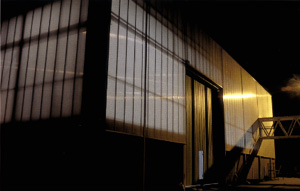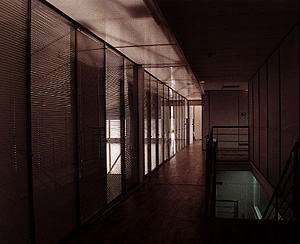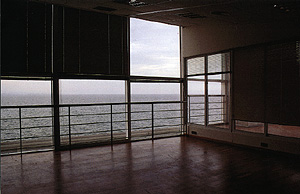| Dentro del ámbito
portuario de Valencia, en el muelle de Levante, antiguo emplazamiento de desguaces, se
encuentra una plataforma saliente hacia la dársena, y por tanto, con lámina de agua en
dos laterales. Sobre ella se propone la ejecución de un edificio de almacenes y oficinas
para la empresa TEMASA. (Telecomunicaciones Marinas S.A.) vinculadas al grupo TELEFÓNICA
S.A. Su principal actividad es el almacenamiento de equipos de reparación y tendido de
cable y fibra óptica por el Mediterraneo, así como, silos de almacenamiento del cable,
talleres de reparación, empalme, y distintos almacenes para asistencia a los barcos de
tendido. Su actividad es diurna y
nocturna, y las condiciones de iluminación, control y dominio de las maniobras internas y
con el buque cabrero, fundamentales. Por ello el proyecto se plantea como una caja que
atrapa una porción de atmósfera, siempre luminosa. De día cambiante, con sus
contrastes. De noche actuando como un referente en la dársena, como un reclamo al
buque. Para ello y dado que se propone una edificación en seco, facilmente desmontable,
manipulable y cambiante, se estudia la utilización de un material plástico,
policarbonato bicelular con sistema de montaje oculto y métrica de 0´65 m. que organiza,
modula y articula todo el proyecto. Este único material como envolvente exterior va a
permitir la solución de las cuatro orientaciones, con distintos doblados interiore;
simple hoja, doble lámina plástica, trasdosado de trespa o trasdosado de D.M. para
despachos, todo ello, resuleto en todos los casos con 12 cm. de espesor, a modo de fachada
transventilada a través del propio sistema.
Este material en translucido o opal, permite la
continua dualidad del lleno-vacio. Externamente con luz vertical diurna la materialidad
asemeja a macizo; internamente, sin embargo, es un cierre lumínico. De noche se invierte;
la luz artificial hace el cierre corpóreo, macizo, y sin embargo, por el exterior
es una caja lumínica. Este aspecto cambiante permite al usuario una sensación de cobijo
nocturno y aperturado diurno; es así una materialidad activa al trabajo y función
internos. |
Within the port
area of Valencia, on the Levante Quay, the former site of the ship breakers yard, a wharf
protrudes into the dock and is therefore surrounded by a sheet of water on both sides. It
was proposed to construct a warehouse and office building on this wharf for TEMASA
(Telecomunicaciones Marinas, S.A.) a company connected to the TELEFÓNICA group, Its main
function is to store equipment for optic fibre and cable laying and repair in the
Mediterranean, together with cable storage silos, repair and splicing workshops and a
number of storerooms to serve the cable-laying ships. This activity takes place both by day and by night and the lighting.
visibility an control of all operations are essential, both within the building itself and
at the cable-laying ship. As a result, the project was designed as a box that would catch
a portion of the ever-luminous atmosphere. By day it would reflect the changing
constrasts. By night, it would became a reference point in the dock, like a light to call
in the ship.
Consequently, and also because it was proposed to construct
this building entirely through dry work so that ir waould be easy to dismantle, modify or
change, a bicellular polycarbonate plastic with a concealed assembly system in a 0.65 m
size was the material studied with a view to organizing, modulating and articulating the
entire brief. This single material used as an external wrapper allows the four sides to be
given different inner faces: single wythe, double plasstic sheeting, lined with Trespa
phenolic resin panelling or lined with MD for the offices. In all cases, the thickness is
12 cm and provides a facade that is internallu ventilated by the system itself.
This pearl or translucent material allows a continual duality
of full-empty. Externally, with the light falling vertically during the day, its
materiality appears to be a solid; internally, however, it is a luminous enclosure. At
night this relationship is reversed: the artficial light makes the enclosure corporeal and
solid from the inside, whereas from the outside it is box of light. This changing aspect
gives the user a sense of shelter at night and opening up during the day. As a result, it
is an materiality that actively interacts with the function and work being performed in
its interior |
 

|
|
|














